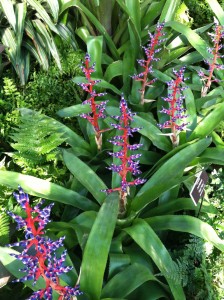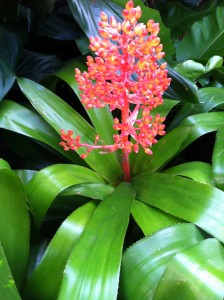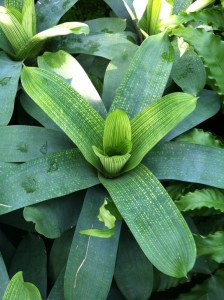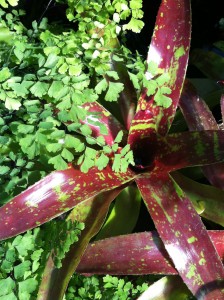Fine Foliage and Bold Bracts
Posted in Horticulture on March 17 2015, by Sonia Uyterhoeven
Sonia Uyterhoeven is NYBG‘s Gardener for Public Education.

I find myself surrounded by bromeliads twice each year. During the early summer, when temperatures have sufficiently warmed, high-end landscape designers use these intriguing tropical beauties to dress up window boxes and the small front gardens of Manhattan town houses. And in frosty February and fickle March, though the temperatures make it an unlikely time for a northerner to encounter bromeliads, you’ll find colorful Neoregelia, showy Vriesea, and floriferous Aechmea thriving in the safe haven of our Conservatory.
Bromeliads add an important element of design to The Orchid Show with their color and texture. Their broad, lance-shaped foliage emerges gracefully from their vase-like form, adding structure and drama to the display. This year they are complemented by an array of lush, tropical and subtropical ferns. In nature, bromeliads often grow alongside orchids—the show takes this natural association and transforms it into a vibrant and stylized display.
Like orchids, bromeliads can be epiphytic, terrestrial, or lithophytic, making their homes in the heights of the forest canopy, on the ground, or on rocks. They tolerate a broad range of temperatures from near freezing to 100°F, but prefer temperatures that range between 65–90°F during the day and 50–65°F at night.

If you grow a bromeliad as a houseplant, they do best in bright, indirect sunlight. When grown outdoors in the summer, they prefer dappled light and thrive when given the mild morning sun. Potting soils need to hold moisture yet drain quickly. A mix of 50% soilless potting mix with 50% fine grade orchid mix works well.
Tank bromeliads are plants that hold water in the reservoirs of their leaves. The roots serve to anchor the plants, while the leaves take on the function of water and nutrient absorption. The cups (at the center of the vase-like form) should be full of water at all times, so flush them with water once a week. The potting medium should be watered but allowed to approach drying out between each watering.
Many bromeliads die after flowering. They produce “pups” or small offshoots that develop around the base of the plant. These can be separated from the parent when the pups are 1/3 to 1/2 the size of the parent plant. You can also cut the dead parent back to its base and leave the pups to grow and fill in the remaining space. Other bromeliads form colonies by producing clusters of plants on stolons (long shoots that grow along the surface of the soil).
In The Orchid Show: Chandeliers, we have a non-stop supply of fine foliage and colorful bracts. Aechmeas are tank bromeliads that have some of the most fanciful inflorescence. One of my favorite is Aechmea ‘Del Mar’. It has grassy green leaves and a hot pink flower spike replete with cobalt blue bracts and whitish-blue flowers.
If you like a plant with a bit more sizzle, then Aechmea ‘Burning Bush’ is the one for you. It’s glossy, bright green foliage acts as a foil for the red-orange inflorescence. Aechmea chantinii ‘Little Harv’ has thick, lance-shaped silver foliage with a salmon-pink spike and bracts that sport yellow flowers. It creates a formidable cacophony of color—one that startles in just the right way.

While bromeliads can be beautiful, some can also be ferocious. The edges of their lance-shaped leaves carry small, sharp spines. While the three Aechmeas mentioned above are spiny, Aechmea ‘Harvito’ has spineless, dark green foliage with a vivid pink bloom. If you are interested in colorful foliage as well as flowers, then a good choice is Aechmea ‘Frappuccino’, with white striations running through its copper-colored foliage.
Before I get too far ahead of myself, perhaps some explanation is called for. A bract is a modified leaf with a flower or cluster of flowers in its axil. Chances are good that you’ve seen one before. The classic examples are poinsettia and bougainvillea. The colorful structures that have the appearance of flower petals are actually bracts, and the miniscule or insignificant flowers are tucked in their center. In many instances, the bracts are there to attract and guide pollinators to the small flowers.
I mentioned earlier that in many bromeliads the mother plant dies once it flowers and creates “pups.” Aechmeas fall into this category. But here’s the good news: the inflorescence on many of these bromeliads lasts for several months—almost the lion’s share of a year on some plants. The mother plant also takes her time while she declines and the pups are being formed.
Vriesea are also typically tank bromeliads. Their foliage is variable in color, ranging from shiny grass green to intricately mottled leaves. The flowers are born on sword-shaped spikes with colorful bracts and tubular flowers.

Delta Maidenhair Fern
The Orchid Show coincides with the display of two beautiful, mottled-leaf varieties of bromeliad. Vriesea gigantea ‘Nova’ is an epiphyte or lithophyte from Brazil that forms a large rosette with green and creamy yellow foliage. Vriesea ospinae var. gruberi is a native of Columbia that has a variable striped color pattern ranging from pale yellow to cream mixed with shades of burgundy.
Neoregelia do not have showy flowers, but they compensate with exceptional foliage. They look their best when the light levels are on the higher side (not too shady). If you over-fertilize these bromeliads, the colorful foliage will remain green. We have Neoregelia ‘Cookie’ and ‘Guacamole’ in the show. The latter is an appetizing mélange of bright burgundy red and apple green. ‘Cookie’ is variegated with a trio of pronounced green, rosy pink, and cream stripes.
If showy and somewhat exotic are traits you love in a houseplant, bromeliads are a likely choice at almost any time of year—and, with the proper care, that counts even here in New York. Keep an eye out for these lush beauties during The Orchid Show: Chandeliers, now through April 19.

